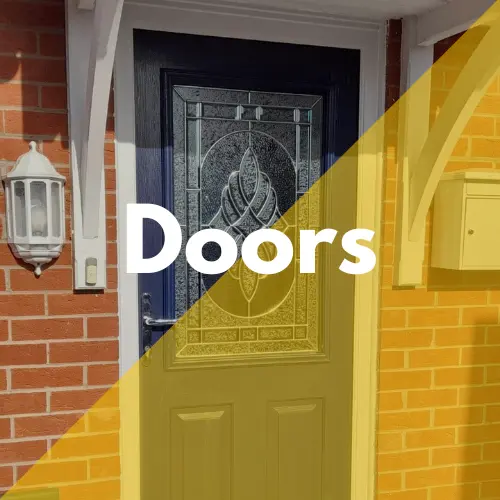Window and Door Terminology
When it comes to window and door terminology, there is a tendency for there to be a great discrepancy in what people think they know about windows based on knowledge being mostly spread through word-of-mouth, and the technical terms we use in this industry. At Trendguard, we want all our customers to be fully informed on the choices they make when they choose to go with us. This is why we have produced a comprehensive, in-depth list of both common, as well as advanced technical terms used for doors and windows, and what they mean.
A-G Energy Performance Ratings
- The majority of products, properties and processes are ranked based on their energy efficiency. This includes: how much energy they require to function; how efficiently they use the energy they require to function for their intended purposes – for example, a heater with an unnecessary amount of lights built into it that will switch on when powered is an inefficient use of energy, whilst a filament lightbulb emitting a large amount of thermal energy is also energy inefficient – and their insulative/conductive properties – whichever one is desired.
- Windows and doors are rated in a similar way to other products. Although they are not responsible for producing heat, they can be assessed on their capabilities of insulating the interior rooms from both exterior coldness, and from the heat of the room escaping outside. This is why all our windows are as a minimum, A-rated as standard for new uPVC windows, as they are the most energy efficient window frame styles available
- This is an important part of window and door terminology, as the energy rating of your windows and doors also has an affect on the overall energy rating of your property, which may either increase/decrease your house value depending on whether your windows and doors can raise the energy efficiency of your home, or not, respectively. You can find your property’s energy rating if it has an Energy Performance Certificate (EPC). Every verified EPC is located on the Gov.UK website, and can be found here.
Bars
- Astragal bars – these window bars are fitted to to the windows both internally, externally, and in-between the separate glass panels. Astragal bars are mainly only used to maintain a property’s traditional aesthetic, such as cottages and listed buildings.
- Drip bars – placed at the bottom of doors and on some tilt-and-turn windows, drip bars prevent rainwater from collecting at the bottom of the doors/windows by creating a slope made from PVC to deflect rainwater droplets, as well as causing rainwater to run-off the door as it trickles downwards.
- Georgian bars – fitted only on the inside of the windows, Georgian bars arose from the Georgian period and were designed to hold smaller window panels in place as opposed to producing single, larger panels which would have been impossible with the window manufacturing processes at the time. Although most people replace their old, Georgian windows to modern uPVC casement windows, or even windows with astragal bars instead so that visually it appears similar in resemblance, some property owners whose property is designated within a conservation area may choose to simply repair/replace their old Georgian windows to new Georgian windows. This is so their property retains the cultural and historical significance of the area, which in-turn enhances their property and area’s touristic attraction.
- Security bars – fitted externally or internally to the surrounding wall, security bars are built to prevent a break-in in the event that the windows are damaged or destroyed. They are different to astragal/Georgian bars as they are not fitted within the window panels, and resultantly are far less appealing. Unfortunately, this is something we cannot provide at Trendguard.
Cassettes
- Inner cassettes – in window and door terminology, inner cassettes are the frames built into a door’s window panels, provided it has them, to hold the window pane(s) in place.
- Outer cassettes – also called mainframe cassettes, outer cassettes clip onto the inner cassette to hold the window panel(s) to the door so that it doesn’t fall out, and is in-turn clipped onto an outer casing layer which protects the cassettes, whilst also giving a smooth finish for the window frame within the door.
Handles
- Dummy door knobs – these are door knobs which are made as a decorative piece, to pull open and to push close a door, and have no involvement in the locking mechanism of the door itself.
- Inline bars – these T-bars are handles which stick out directly from the door at a 90° angle, are used to open/close the door. Due to there being no lever action where you could pull the handle down, only certain locks can be fitted for these types of handles, so that no movement of the handle is required to move a shootbolt to be able to unlock it.
- Lever handles – the most commonplace door handle seen on over 90% of external doors in the UK, lever handles are versatile to be used for all types of locks and door designs due to the simplicity of their design, and how they have been standardised for every door. They are also used on windows as well – due to their sleek design, they can be positioned at the bottom of the window cassette without contacting the window frame when being opened and closed.
- Offset bars – similarly to inline bars, offset bars are also T-shaped bars with the only difference being that the two metal parts which are attached to the door itself move out at an angle. This is a result of their two metal parts being cut at an angle, then being fixed to the door by the angle they are cut.
- Twist door knobs – this type of door knob interacts with the locking mechanism, either by the keyhole being built into the centre of the knob or next to it, wherein the door knob will need to be twisted to open the latch after the door has been unlocked; similarly compared to a lever handle.
Hinges
- Awning windows – these windows are hinged at the top of the window frame, and will open from the bottom of the frame by swinging outwards.
- Ball-bearing hinges – designed for use on entry doors to withstand the elements, these door hinges are the most durable of the butt hinges. These use hidden bearings in between its knuckles, which allows the hinges to open and close smoothly by minimising friction forces.
- Butt hinges – the most common type of hinges used on doors, butt hinges consist of two rectangular screw-holed leaves, joined together by their interlocking knuckles being secured by a pin from the top.
- Cylinder hinges – also known as concealed/invisible hinges, these door hinges use a complex design where the hinges themselves are built into the door itself, rather than being screwed onto the surface.
- Heavy-duty hinges – used more so in harsher environments where there is a constant transportation of large, heavy objects in and out of large, heavy doors, heavy-duty hinges use denser alloys and a larger mass of metal to create stronger versions of the other types of door hinges from ball-bearing to strap hinges.
- Hopper windows – oppositely to awning windows, hopper windows are hinged at the bottom of the window frame, and vice-versa open from the top of the frame by swinging outwards.
- Pivot hinges – pivot hinges are fixed the top and bottom faces of a door, allowing it to swing from one point. Designed to handle heavier doors than other door hinges, pivot–hinged doors are used to connect the doors can be opened easily with one push.
- Offset hinges – offset door hinges allow the door to be swung away from the doorframe, which widens the opening by up to two inches. This improves the accessibility into and out of the room, especially for people who use a wheelchair.
- Spring-loaded butt hinges – ideal for screen doors which are built in front of the main external doors of a property, spring-loaded butt hinges can be configured by altering the tension of the spring which will dictate the force at which they retract back to their frame after releasing them from being opened.
- Strap hinges – these are some of the oldest door hinge designs characterised by a long, slim design. Strap hinges consist of two triangular–shaped pieces of metal connected by a rotating axis at the centre. This rotating axis allows for the strap hinge to open and close.
Locks
- Escutcheons – these can either act as coverings to protect keyholes on doors, and occasionally windows, or they are simply keyhole profiles which are mounted on the surrounding keyhole with a keyhole shape carved out at the centre of the profile. This serves to protect the lock in the door.
- European cylinder locks – these barrel-shaped locks are used on modern uPVC doors in Europe, and are among the most popular locking systems in the UK. These door locks may require a different type of key to unlock them, since there are several variants of European cylinder locks available.
- Night latch – these are locks where the locking mechanism is built on one side of the door’s surface (the interior side), where they are mounted to doors that open inwards and mounted to the inner surface of the door. When the door is closed the night latch automatically latches the door shut. It can then be reopened from the inside without needing to unlock it with a key, but not from the outside. Night latches are normally used as an additional security feature rather than on their own.
- Shootbolts – most notably used in locks for the Yale brand, shootbolts are designed to prevent individual lockpickers from picking a locked door, by requiring the use of one hand to keep the handle turned upwards to keep the bolt open, allowing for the lockpicking tools to enter and pick the locking pins.
Seals
- Gasket – also known as a window/door seal/seal gasket, these are strips of material which are fixed between the window panes and around the window/door frames to prevent any condensation/draught/leakages from seeping into and through the windows which would make the window less energy efficient, and more susceptible to damage.
- Weatherstripping – this is a simple type of gasket that uses rubber which is either adhered to the frame using a peel-and-stick adhesive, or by being inserted into a kerf on the door frame, which is then known as a kerf seal.
Thresholds
- Bumper seal thresholds – this type of threshold consists of a seal at the top that connects to the door when its closed. The benefit of this is that the bumper seal threshold acts as a seal for the bottom of the door that in turn, prevents draughts and moisture from entering. It is important to consider the undercut of the door (the bottom of the door) when considering fixing a bumper seal threshold.
- Dividers – these door thresholds are most commonly used between rooms where internal doors are placed. These dividers are built to divide up the flooring between rooms, rather than having a bulkier threshold which you would see at the front external door on your property. Dividers are crucial in fire-rated environments, as they – in the event of a fire – aid in preventing fires travelling underneath the door.
- Heavy-duty thresholds – as the name suggests, heavy-duty thresholds are designed to withstand heavy and frequent foot traffic. This is ideal for indoor and outdoor use from hospitals to factories where heavy machinery would pass through constantly. Heavy-duty thresholds are therefore designed using denser metals, oftentimes stainless steel, to withstand constant traffic.
- Saddle thresholds – These thresholds are moulded into a saddle-like shape, wherein its thresholds are intended for typically larger, metal door thresholds and can be supplied with supports underneath that run the full length of the threshold. For safety reasons, saddle thresholds can be bought with groves to reduce the risk of slipping. You may witness saddle thresholds lining doors at outdoor events, such as weddings, festivals and outdoor corporate events. Depending on how and where you plan to use the saddle threshold, the thickness of the metal will need to be considered.
- Thermal break thresholds – these door thresholds are designed to prevent draughts from entering/exiting your room from the floor. Thermal break thresholds also stop condensation building up at the bottom of the door, which could put the door at risk of developing mould overtime. Thermal breaks are placed in the middle of the threshold, and also contain bumper seals that can be similarly shaped to saddle thresholds.
We hope this breakdown of window and door terminology will assist you when understanding the technical details many people are encumbered with when deciding on new windows and doors. Now, when using our door designer, you should be confident in the choices you make when finalising your own door design!











